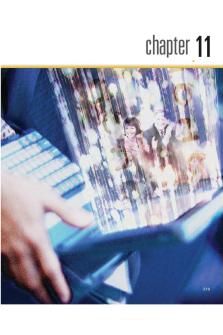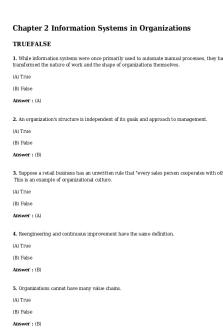Chapter 2 - Summary Management Information Systems PDF

| Title | Chapter 2 - Summary Management Information Systems |
|---|---|
| Author | Cherrise Nicole |
| Course | Managing Information Systems |
| Institution | University of Regina |
| Pages | 6 |
| File Size | 78.7 KB |
| File Type | |
| Total Downloads | 57 |
| Total Views | 147 |
Summary
Chapter summary and lecture notes included....
Description
BUS375 Chapter 2 How Businesses Use Information -
-
Business Processes and Info Systems Business Processes o Every business can be seen as a collection of business processes o Workflows of material, info, knowledge o Sets of activities, steps o May be tied to functional area/be cross-functional o May be assets or liabilities How Info Tech Improves Business Processes o Increases efficiency of existing processes o New info tech frequently changes the way a business works and supports entirely new business models o Analyze business processes = achieve a clear understanding of how a business works o Eliminate delays in decision making Types of Info Systems Functional systems operating independently from each other are becoming outdated because they cannot easily share info to support cross-functional business processes Systems for Different Management Groups o Transaction Processing Systems: a computerized system that performs and records the daily routine transactions necessary to conduct business, such as sales order entry, hotel reservations, payroll, employee record keeping, and shipping Principle purpose = answer routine questions and track the flow of transactions through the organization Managers need this to monitor the status of internal operations and the firm’s relations with the external environments Major producers of info for the other systems and business functions Failure for a few hours = firms demise and perhaps that of other firms linked to it o Systems for Business Intelligence: data and software tools for organizing, analyzing, and providing access to data to help managers and other enterprise users make more informed decisions Focus on delivering info to support management decision making Middle management – help with monitoring, controlling, decision making and admin activities MIS – provides middle managers with routine reports on the organization’s current performance o Used to monitor and control the business and predict future performance
BUS375 Chapter 2 How Businesses Use Information
o Summarize and report on the company’s basic operations using data supplied by TPS o Provide answers to routine questions (specified in advance with predefined procedure for answering them) o Most use simple routines (ex: summaries/comparisons) Decision-support Systems (DSS): focus on problems that are unique and rapidly changing, and for which the procedure for arriving at a solution may not be fully predefined in advance o “What would be the impact on production schedules if we were to double sales in December?” o Uses internal info from TPS and MIS as well as bringing in info from external sources (ex: stock prices, prices of competitors) o Employed by “super-user” managers and business analysts Address decision-making needs of sr management o “What will employment levels be in five years?” Executive Support System (ESS): helps senior management make decisions o Address non-routine decisions requiring judgment, evaluation and insight o Info delivered to senior execs through a portal o Designed to incorporate data about external events and draw summarized info from internal MIS and DSS o Filter, compress and track critical data to display data of greatest importance to sr managers Digital dashboard: displays (on a single screen) graphs and charts of key performance indicators for managing a company Systems for Linking the Enterprise o Enterprise Applications: systems that span functional areas, focus on executing business processes across the business firm, and include all levels of management Help businesses become more flexible and productive by coordinating their business processes more closely and integrating groups of processes to focus on efficient management of resources and customer service Costly and difficult to implement Four major ones: o Enterprise Systems: integrates business processes in manufacturing and production, finance and accounting, sales and marketing, and HR into a single software system AKA Enterprise Resource Planning (ERP) Systems
BUS375 Chapter 2 How Businesses Use Information
o Supply Chain Management (SCM) Systems: helps manage relationships with their suppliers Helps suppliers, purchasing firms, distributors, and logistics companies share info about orders, production, inventory, and delivery of products/services Ultimate objecting = get the right amount of their products from their source to their point of consumption in the least amount of time and lowest cost Type of interorganizational system because automates the flow of info across organizations o Customer Relationship Management (CRM) Systems: helps manage relationships with customers Provides info to coordinate all business processes that deal with customers in sales, marketing, and service to optimize revenue and customer satisfaction/retention Helps identify/attract/retain profitable customers, provides better service, and increases sales o Knowledge Management Systems (KMS): enable organizations to better manage processes for capturing and applying knowledge and expertise Collect all relevant knowledge and experience in the firm and make it available to wherever/whenever needed to improve business processes and management decisions Links the firm to external sources of knowledge o Intranets and Extranets Alternative tools for increasing integration and expediting flow of info within firm and with customers and suppliers Intranets: internal company websites accessible only by employees Extranet: accessible to authorized vendors and suppliers, often used to coordinate movement of supplies to the firm’s production facility E-business, E-commerce and E-government o E-business: the use of digital technology and the Internet to execute the major business processes of an enterprise Includes activities for the internal management of the firm and for coordination with suppliers/business partners
BUS375 Chapter 2 How Businesses Use Information
-
Includes e-commerce o E-commerce: part of e-business that deals with the buying/selling of goods and services over the internet Includes advertising, marketing, customer support, security, delivery and payment o E-government: refers to the application of the Internet and networking technologies to digitally enable gov’t and public-sector agencies’ relationships with citizens, businesses and other arms of gov’t Makes gov’t operations more efficient and provides citizens with info and the ability to network electronically with other citizens Systems for Collaboration and Social Business Collaboration: working with others to achieve shared and explicit goals o Focuses on task/mission accomplishment o Usually takes places in a business/other organization and between businesses o Short-lived or long-term o Teams: have a specific mission that someone in the business assigned to them Often short-lived o Reasons why important: Changing nature of worm Growth of professional work Changing organization of the firm Changing scope of the firm Emphasis on innovation Changing culture of work and business Social Business: the use of social networking platforms to engage employees, customers and suppliers o Key word = conversations o Supporters say firms can use this to strengthen their bonds with customers/suppliers/employees to increase their emotional involvement in the firm Business Benefits of Collaboration and Social Business o Investments in collaboration tech = organizational improvements returning over 4x the amount of investment o Increase productivity – solving problems rapidly with fewer errors o Increase quality – communicate errors and take corrective action faster o Increase innovation – more ideas for products, services and admin o Increase customer service – solve customer complaints/issues faster and more effectively o Increase financial performance
BUS375 Chapter 2 How Businesses Use Information
-
Building a Collaborative Culture and Business Processes o Sr managers responsible for achieving results but rely on teams of employees to achieve and implement them o Policies/products/designs/processes/systems dependent on teams at all levels to devise/create/build o Teams rewarded for performance/individuals of the team rewarded o Middle managers – build the teams, coordinate their work and monitor their performance o Culture and processes more “social” o Collaboration and teamwork vital to the organization Tools and Technologies for Collaboration and Social Business o Need info systems in place for collaborative teams to produce benefits, including: E-mail and IM Wikis Virtual Worlds Collaboration and Social Business Platforms o Virtual meeting systems Telepresence: an integrated audio and visual environment that allows a person to give the appearance of being present at a location other than their true physical location o Google apps/Google sites and Cloud Collab Services Cyberlocker: online file-sharing service that allows users to upload files to secure online storage sites from which the files can be shared with others Ex: Dropbox o Microsoft SharePoint o Lotus Notes o Enterprise social networking tools The Info Systems Function in Business Information Systems Department: the formal organizational unit responsible for info tech services o Programmers: highly trained technical specialists who write the software instructions for computers o Systems Analysts: constitute the principal liaisons between the info systems groups and the rest of the organization Translates business problems and requirement into info requirements and systems o Information Systems Managers: leaders of teams of programmers and analysts, project managers, physical facility managers, telecommunications managers, or database specialists
BUS375 Chapter 2 How Businesses Use Information
-
Managers of computer operations and data entry staff o Chief Information Officer (CIO): often the head of the info systems department. Senior manager who oversees the use of info tech in the firm Should have a strong business background and info systems expertise Plays a leadership role in integrating tech into the firm’s business strategy o Chief Security Officer (CSO): in charge of info systems security for the firm and for enforcing the firm’s info security policy Responsible for educating and training users and info systems specialists about security, keeping mgmt. aware of threats and breakdowns, and maintaining tools and policies chosen to implement security o Chief Privacy Officer (CPO): responsible for ensuring the company complies with existing data privacy laws o Chief Knowledge Officer (CKO): responsible for the firm’s knowledge management program Helps design programs and systems to find new sources of knowledge/make better use of existing knowledge o End Users: representatives of departments outside of the info systems group for whom applications are developed Organizing the Info Systems Function Very small companies = no formal info systems group IT Governance: includes the strategy and policies for using info tech within an organization o Specifies the decision rights and framework for accountability to ensure the use of info tech supports their strategies and objectives...
Similar Free PDFs

Management information systems
- 2 Pages

Chapter 11 - Information Systems
- 26 Pages

Chapter 9 Global Information Systems
- 65 Pages

Information Systems
- 5 Pages
Popular Institutions
- Tinajero National High School - Annex
- Politeknik Caltex Riau
- Yokohama City University
- SGT University
- University of Al-Qadisiyah
- Divine Word College of Vigan
- Techniek College Rotterdam
- Universidade de Santiago
- Universiti Teknologi MARA Cawangan Johor Kampus Pasir Gudang
- Poltekkes Kemenkes Yogyakarta
- Baguio City National High School
- Colegio san marcos
- preparatoria uno
- Centro de Bachillerato Tecnológico Industrial y de Servicios No. 107
- Dalian Maritime University
- Quang Trung Secondary School
- Colegio Tecnológico en Informática
- Corporación Regional de Educación Superior
- Grupo CEDVA
- Dar Al Uloom University
- Centro de Estudios Preuniversitarios de la Universidad Nacional de Ingeniería
- 上智大学
- Aakash International School, Nuna Majara
- San Felipe Neri Catholic School
- Kang Chiao International School - New Taipei City
- Misamis Occidental National High School
- Institución Educativa Escuela Normal Juan Ladrilleros
- Kolehiyo ng Pantukan
- Batanes State College
- Instituto Continental
- Sekolah Menengah Kejuruan Kesehatan Kaltara (Tarakan)
- Colegio de La Inmaculada Concepcion - Cebu











